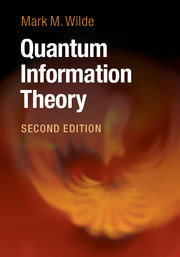Book contents
- Frontmatter
- Contents
- Preface to the Second Edition
- Preface to the First Edition
- How To Use This Book
- Part I Introduction
- Part II The Quantum Theory
- 3 The Noiseless Quantum Theory
- 4 The Noisy Quantum Theory
- 5 The Purified Quantum Theory
- Part III Unit Quantum Protocols
- Part IV Tools of Quantum Shannon Theory
- Part V Noiseless Quantum Shannon Theory
- Part VI Noisy Quantum Shannon Theory
- Appendix A Supplementary Results
- Appendix B Unique Linear Extension of a Quantum Physical Evolution
- References
- Index
5 - The Purified Quantum Theory
from Part II - The Quantum Theory
Published online by Cambridge University Press: 16 February 2017
- Frontmatter
- Contents
- Preface to the Second Edition
- Preface to the First Edition
- How To Use This Book
- Part I Introduction
- Part II The Quantum Theory
- 3 The Noiseless Quantum Theory
- 4 The Noisy Quantum Theory
- 5 The Purified Quantum Theory
- Part III Unit Quantum Protocols
- Part IV Tools of Quantum Shannon Theory
- Part V Noiseless Quantum Shannon Theory
- Part VI Noisy Quantum Shannon Theory
- Appendix A Supplementary Results
- Appendix B Unique Linear Extension of a Quantum Physical Evolution
- References
- Index
Summary
The final chapter of our development of the quantum theory gives perhaps the most powerful viewpoint, by providing a mathematical tool, the purification theorem, which offers a completely different way of thinking about noise in quantum systems. This theorem states that our lack of information about a set of quantum states can be thought of as arising from entanglement with another system to which we do not have access. The system to which we do not have access is known as a purifying system. In this purified view of the quantum theory, noisy evolution arises from the interaction of a quantum system with its environment. The interaction of a quantum system with its environment leads to correlations between the quantum system and its environment, and this interaction leads to a loss of information because we cannot access the environment. The environment is thus the purification of the output of the noisy quantum channel.
In Chapter 3, we introduced the noiseless quantum theory. The noiseless quantum theory is a useful theory to learn so that we can begin to grasp an intuition for some uniquely quantum behavior, but it is an idealized model of quantum information processing. In Chapter 4, we introduced the noisy quantum theory as a generalization of the noiseless quantum theory. The noisy quantum theory can describe the behavior of imperfect quantum systems that are subject to noise.
In this chapter, we actually show that we can view the noisy quantum theory as a special case of the noiseless quantum theory. This relation may seem strange at first, but the purification theorem allows us to make this connection. The quantum theory that we present in this chapter is a noiseless quantum theory, but we name it the purified quantum theory, in order to distinguish it from the description of the noiseless quantum theory in Chapter 3.
The purified quantum theory shows that it is possible to view noise as resulting from entanglement of a system with another system. We have actually seen a glimpse of this phenomenon in the previous chapter when we introduced the notion of the local density operator, but we did not highlight it in detail there.
Information
- Type
- Chapter
- Information
- Quantum Information Theory , pp. 164 - 182Publisher: Cambridge University PressPrint publication year: 2017
